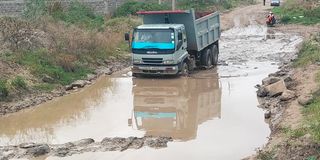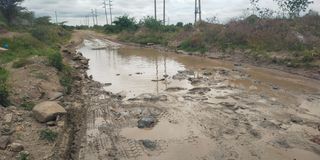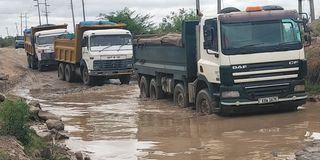Kitengela–Rongai Road in ruins as a decade of promises fade

A truck ferrying construction materials maneuvering on a section of the Kitengela-Ongata Rongai road on March 20, 2025.
On a normal day, balls of heavy dust spiral up, covering dozens of trucks meandering along the deplorable Kitengela-Ong’ata Rongai road, ferrying construction and cement-making raw materials.
With the onset of the April seasonal rains, dozens of gaping potholes fill with floodwater, turning the road into a nightmare not only for locals but also for raw material transporters.
To the locals, the strategic bypass is an economic gem that has suffered a false start for almost a decade.
The 30-kilometer road connects the populous Kitengela town in Kajiado East sub-County to Ong’ata Rongai township in Kajiado North Sub County, and touches a part of Machakos County in the Embakasi neighbourhood.
It also provides access to numerous quarries for quarry stones and pozzolana—key ingredients in cement processing—located in both Sholinke and Nkurunka villages. Most cement processors outsource pozzolana from these areas.

Deplorable Kitengela-Ong'ata Rongai road that serves as a bypass.
The road runs parallel to the Nairobi National Park boundary and the Standard Gauge Railway (SGR) line to Tuala neighbourhood. It then extends past the African Nazarene University to the SGR Ong’ata Rongai station, continuing to Limpa before finally connecting to Magadi Road.
However, over the years, locals have endured untold suffering, with investors reportedly relocating in droves. Rental house owners and transporters have been left counting losses.
The Nation spot check
A Nation.Africa spot check on Thursday found that the road was last rehabilitated by the Kenya Rural Roads Authority (KeRRA) in 2014. Despite numerous protests from transporters and locals, no major rehabilitation has taken place since.
According to KeRRA records, Sh232 million was spent through the Ministry of Nairobi Metropolitan to rehabilitate the road.
Many rental houses along the road within Kitengela town are either deserted or have few tenants. Multi-million-shilling residential homes have suffered the same fate, with some owners relocating due to dust and poor road conditions.
"We are on our own. The deplorable state of the road has forced tenants to relocate. During the rainy season, floodwater flows into our rental houses due to poor drainage," said Kois Ole Sungale, 65, a landlord.
The tarmac promise
In an earlier interview, Ms Nancy Njeri, 52, put road authorities on the spot, blaming them for unfulfilled promises to tarmac the road for years. The single mother of two told Nation.Africa that she has been forced to "hang on" despite the dust and noise from trucks, as she cannot afford to rent a more expensive house elsewhere in Kitengela.
"Dust-filled air constantly floats around our home during dry seasons. You can't wash clothes and hang them outside to dry because of the dust. It’s hectic and compromises our health," she said.
The tarmacking of the road has been advertised several times by both KeRRA and the Kenya Urban Roads Authority (KURA) over the last ten years, only for plans to stall. The road is classified as a "C" road under KeRRA's jurisdiction.
Currently, some sections of the road are impassable, forcing transporters to trespass through private lands at a fee of Sh100 per trip, depending on how many separate parcels of land the truck crosses.
At least 400 trucks use the route daily. The Kajiado County government charges Sh1,600 per truck ferrying pozzolana and Sh500 per truck carrying other building materials. These trucks operate six days a week, from Monday to Saturday.
Most truck drivers who spoke to the Nation on Thursday said daily trips per truck have reduced from five to just two due to the road's deteriorating state.

Trucks ferrying construction materials manoeuvre through a section of the deplorable Kitengela-Ongata Rongai road.
"From 4am to 5pm, a truck can now hardly complete three trips. Vehicle breakdowns are also more frequent, making the trade almost untenable," said a driver ferrying pozzolana to a major cement processor in Athi River township.
Another driver blamed both levels of government, saying, "Our trucks bear the biggest brunt of the bad road. The national and county governments collect billions in revenue annually, yet they are reluctant to make the road passable," said George Mutua.
Hundreds of residents living along this bypass rely on stone-loaded trucks for transport to Kitengela or Ong’ata Rongai towns, risking their lives since no public service vehicles (PSVs) ply the route. The only alternative is the expensive and time-consuming Kitengela-Nairobi-Ong’ata Rongai route.
Also Read: Most roads in Nairobi in bad condition
Land prices affected
For locals, the poor road conditions have stalled land price appreciation for years, with minimal value growth recorded. A handful of major investors have reportedly relocated to the Lukenya region in neighbouring Machakos County.
"Our region’s proximity to Nairobi gives us a head start in property value, but the bad road has been a major deterrent. Land appreciation is minimal, and investors are leaving in droves," said Wilson Kisemei.
The economic backbone of Nkurunka and Sholinke villages has long been quarrying activities. The region boasts some of the largest stone and pozzolana quarries in Kajiado County, but now locals fear for their livelihoods.
"Dozens of locals rely on quarries for survival. We are forced to temporarily close operations during the rainy season. The once-thriving stone and pozzolana business has been crippled by the poor road conditions," said Peter Morindat.
Also Read: Fix bad roads in Nairobi
Kajiado East MP Kakuta Maimai stated that KeRRA had allocated Sh15 million for road rehabilitation.
"Recently, KeRRA allocated Sh15 million for murraming and grading the road from Tuala town. This road is the economic backbone of my constituency’s urban population," Maimai said.
He added, "Tarmacking this road is long overdue. It can be transformed into a golden goose for locals. It remains a key artery for growth in the two satellite towns within the Nairobi metropolitan area."
The road is crucial to Kajiado County’s economy, given that many landowners along the route have converted portions of their vast land into quarries. The county government charges Sh100,000 per quarry as an annual operation fee.
Kajiado County Resident Engineer Washington Mugambi told Nation.Africa that road tarmacking has been delayed due to a lack of funding for the past three financial years, with Sh1.56 billion initially quoted for the work.
"Our team from headquarters has been on the ground working on the road design. We are hopeful that funds will be allocated in the 2025/2026 financial year. In the meantime, we are moving swiftly to rehabilitate the road," said Engineer Mugambi.

